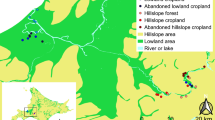Abstract
Long-term assessments of species assemblages are valuable tools for detecting species ecological preferences and their dispersal tracks, as well as for assessing the possible effects of alien species on native communities. Here we report a 50-year-long study on population dynamics of the four species of land flatworms (Platyhelminthes, Tricladida, Terricola) that have colonized or become extinct in a 70-year-old Atlantic Forest regrowth remnant through the period 1955–2006. On the one hand, the two initially most abundant species, which are native to the study site, Notogynaphallia ernesti and Geoplana multicolor have declined over decades and at present do not exist in the forest remnant. The extinction of these species is most likely related with their preference for open vegetation areas, which presently do not exist in the forest remnant. On the other hand, the neotropical Geoplaninae 1 and the exotic Endeavouria septemlineata were detected in the forest only very recently. The long-term study allowed us to conclude that Geoplaninae 1 was introduced into the study area, although it is only known from the study site. Endeavouria septemlineata, an active predator of the exotic giant African snail, is originally known from Hawaii. This land flatworm species was observed repeatedly in Brazilian anthropogenic areas, and this is the first report of the species in relatively well preserved native forest, which may be evidence of an ongoing adaptive process. Monitoring of its geographic spread and its ecological role would be a good practice for preventing potential damaging effects, since it also feeds on native mollusk fauna, as we observed in lab conditions.
Similar content being viewed by others
References
Carbayo F, Leal-Zanchet AM, Vieira EM (2002) Terrestrial flatworm (Platyhelminthes: Tricladida: Terricola) diversity versus man-induced disturbance in an ombrophilous forest in southern Brazil. Biodivers Conserv 11:1091–1104
Christensen OM, Mather JG (1998) The ‘New Zealand flatworm’, Artioposthia triangulata, in Europe: the Faroese situation. Pedobiologia 42:532–540
Ducey PK, West L-J, Shaw G, Lisle JD (2005) Reproductive ecology and evolution in the invasive terrestrial planarian Bipalium adventitium across North America. Pedobiologia 49:367–377
Ducey PK, McCormick M, Davidson E (2007) Natural History Observations on Bipalium cf. vagum Jones and Sterrer (Platyhelminthes: Tricladida), a terrestrial broadhead planarian new to North America. Southeast Nat 6:449–460
Fiore C, Tull JL, Zehner S, Ducey PK (2004) Tracking and predation on earthworms by the invasive terrestrial planarian Bipalium adventitium (Tricladida, Platyhelminthes). Behav Proc 67:327–334
Greenslade P, Stevens MI, Edwards R (2007). Invasion of two exotic terrestrial flatworms to subantarctic Macquarie Island. Polar Biol 30:961–967
Hobbie JE, Carpenter SR, Grimm NB, Gosz JR, Seastedt TS (2003) The US long term ecological research program. Bioscience 53:21–32
Hyman LH (1940) Native and introduced land planarians in the United States. Science 92:105–106
Mead AR (1963) A flatworm predator of the giant African snail Achatina fulica in Hawaii. Malacologia 1:305–311
Müller JC, Griebeler EM (2002) Genetics on invasive species. In: Leppäkoski E, Gollasch S, Olenin S (eds) Invasive aquatic species of Europe. Distribution, impacts and management. Kluwer Academic Publishers, Dordrecht
Parker IM, Simberloff D, Lonsdale WM, Goodell K, Wonham M, Kareiva PM, Williamson MH, Von Holle B, Moyle PB, Byers JE, Goldwasser L (1999) Impact: toward a framework for understanding the ecological effects of invaders. Biol Invasions 1:3–19
Schrader G, Unger J-G (2003) Plant quarantine as a measure against invasive alien species: the framework of the International Plant Protection Convention and the plant health regulations in the European Union. Biol Invasions 5:357–364
Simberloff D, Gibbons L (2004) Now you see them, now you don't! – population crashes of established introduced species. Biol Invasions 6:161–172
Strayer DL, Eviner VT, Jeschke JM, Pace ML (2006) Understanding the long-term effects of species invasions. Trends Ecol Evol 21:645–651
Acknowledgments
We thank W. Mantovani (USP) for the description of the vegetation in the study area; J. S. Morgante (USP) for the sampling license in the Forest Reserve; M. T. Rodrigues (USP) for facilities to use the histological laboratory; CNPq for the research grant PIBIC provided to JP; and J. Grau and J. Hesson for English revision of the manuscript.
Author information
Authors and Affiliations
Corresponding author
Additional information
Júlio Pedroni: Granted by CNPQ–Brazil.
Rights and permissions
About this article
Cite this article
Carbayo, F., Pedroni, J. & Froehlich, E.M. Colonization and extinction of land planarians (Platyhelminthes, Tricladida) in a Brazilian Atlantic Forest regrowth remnant. Biol Invasions 10, 1131–1134 (2008). https://doi.org/10.1007/s10530-007-9190-1
Received:
Accepted:
Published:
Issue Date:
DOI: https://doi.org/10.1007/s10530-007-9190-1




